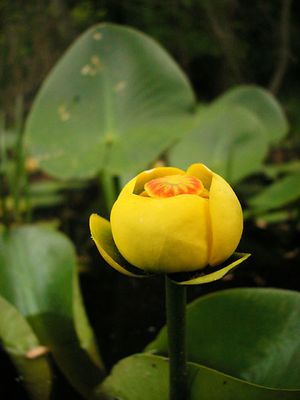Nuphar aduena
Yellow Pond Lily
Yellow Pond Lily is a native water lily which grows in lakes, ponds, and slow-moving rivers. It dies back in the winter, but grows again from the roots each spring.
The plant's thick leaves can be round or heart-shaped. They are large, growing up to 12 inches wide. The leaves are attached to a long stalk which extends down into the water and into the mud below. When the water level drops, the leaves will be above the water. When the water level rises again, the leaves will float on the water.
The flowers of this plant are yellow, with thick petals. Fruit are shaped like pods and contain many seeds.
Additional Information:
Yellow Pond Lilies provides great cover for wildlife, especially fish, aquatic insects, snakes, turtles, frogs, crayfish, salamanders, and other water creatures.
Beaver and Common Muskrats eat the rhizomes, and Beaver also eat the leaves.
Waterfowl, such as Wood Ducks, Mallards, and Canada Geese eat the seeds of Yellow Pond Lily.
Frogs, salamanders, and aquatic insects also use leaves and stems to attach egg masses.
Leaves, or lily pads, provide resting places for terrestrial insects, such as dragonflies and bees.
This plant is also used as a homeopathic treatment for headaches and various maladies.
Height
- Inches
|
 |
Spread
- Inches
|
Home Owner Growing and Maintenance Tips:
Characteristics & Attributes
Hydrologic Designation
|
Nature Attracting
|
Root
|
Season of Interest
| • |
Late (July-frost) |
| • |
Mid (May-June) |
|
Soil Moisture
|
Special Uses
|
Sun Exposure
|
USFS MO Ecological Map
|
Wildlife Benefit
| • |
Food/Birds |
| • |
Food/Small Animals |
| • |
Cover |
|

